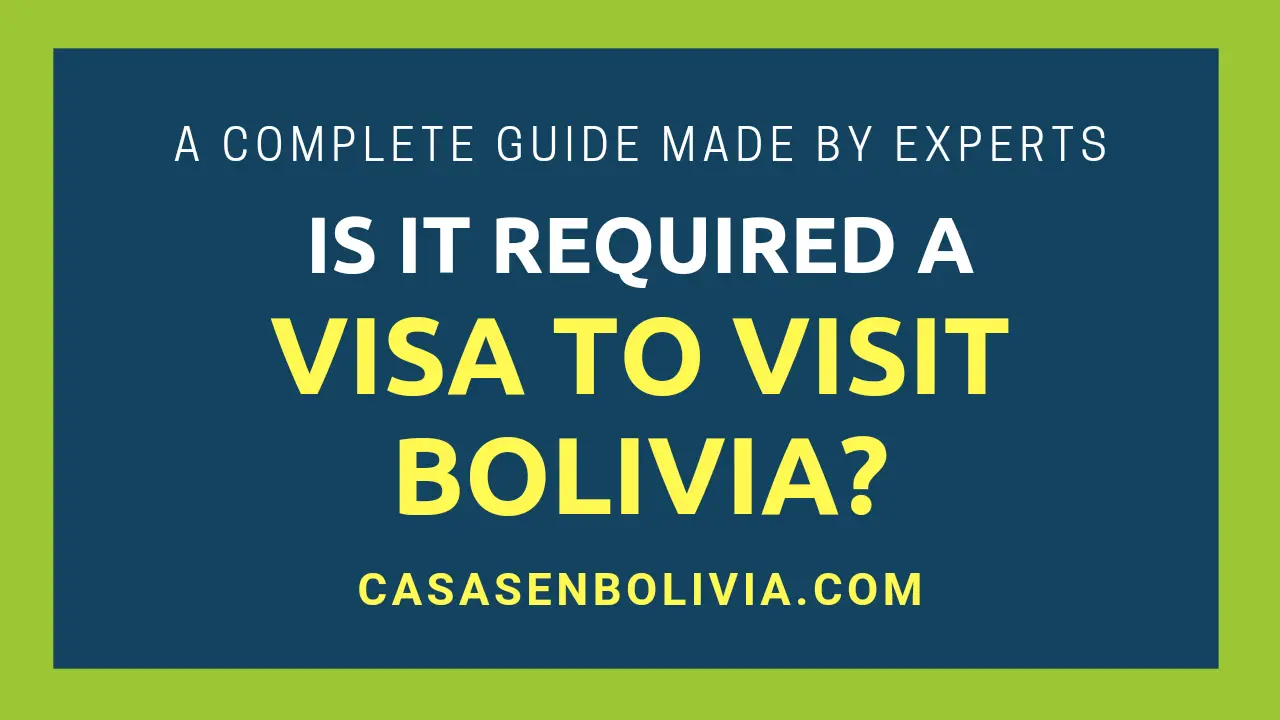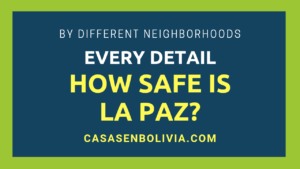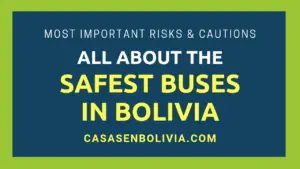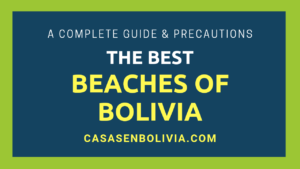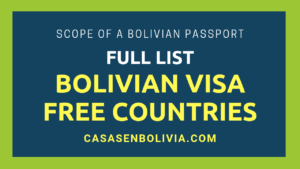Last Updated on February 15, 2025
In Bolivia, citizens from most developed countries, such as the UK, France, Spain, Portugal, Germany, Italy, Australia, Japan, Switzerland, Canada, etc., can enter the country by simply presenting a passport. However, many countries in Asia, Africa, and Central America, along with the US and South Korea, require a tourist visa for entry.
Most developed nations only require a passport for their citizens to enter Bolivia, including many countries in the European Union and South America, as well as Canada, Japan, and Australia. Citizens of other countries, including the US, will always require at least a tourist visa to enter Bolivia.
In this guide, we’ll discuss which citizens from different countries are permitted to enter Bolivia with a valid visa, a passport, or just an ID document. You’ll find an up-to-date and comprehensive list, along with the Bolivian laws governing the entry of foreigners into Bolivian territory. We are Bolivian real estate experts (website) who have lived in Bolivia all of their lives.
General Overview of Visa Requirements for Bolivia
As of 2023, citizens from most developed countries can enter Bolivia *without a visa* (except for the US – Americans always require a visa). This includes most countries in Western Europe, such as England, France, Italy, Spain, Denmark, Germany, etc., as well as other developed nations like Japan and Australia.
Furthermore, citizens from nearly all South American countries and many Central American countries can enter Bolivian territory *without a passport*. In fact, people from these countries are only required to present an ID document to enter our country.
On the other hand, countries experiencing significant political or economic challenges within their territory typically do not have visa-free entry to Bolivia. Some even require “prior review and approval” from the Bolivian Migration Authority (DISEMIG) before a visa is granted.
The US and Puerto Rico
The US and Puerto Rico are special cases. Americans and Puerto Ricans always require a visa to enter Bolivia. They can obtain this visa in two ways:
- By applying at the Bolivian consulate or embassy in their respective countries.
- By obtaining it at the Bolivian border before entering the country (visa on arrival – VOA).
They’ll receive a tourist visa that allows them to stay in Bolivia for 30 days, extendable up to 90 days. The paperwork for the tourist visa costs around $200. More details are available in our dedicated guide: Do US citizens need a visa to enter Bolivia? All the details.
Different Types of Visas to Enter Bolivia
Many foreigners use the “tourist visa” issued by the Bolivian government to enter and stay in Bolivia. However, other visa types are available that allow individuals to engage in activities beyond tourism. [Link]
- Work Visa
- Student Visa
- Health Visa
- Family Visa
- “Specific Purpose” Visa
- Multiple Entry Visa
- Humanitarian Visa
- Invitation Visa
- And other more specific visas.
Obtaining a “tourist visa” is relatively straightforward for citizens of almost any country wishing to enter Bolivia. What’s more challenging is acquiring the other types of visas mentioned above, as each is designed for a specific purpose within the country (e.g., the student visa for studying) *that must be proven and verified* before the visa is granted.
You can follow the links to learn every detail about each visa mentioned in the list above, including how to obtain them, their restrictions, validity periods, costs, and other details.
In general, a citizen of almost any country worldwide can visit Bolivia by obtaining a “tourist visa,” which allows them to stay in the country for at least 30 days, up to 90 days. Obtaining this visa is free for most countries, costs $30 for some, and around $200 for the US and Puerto Rico.
Governing Laws and Regulations
Now, let’s examine the current laws that govern the entry of foreigners into Bolivian territory.
The following Supreme Decree established three groups of countries based on their requirements for entering Bolivia (either with a visa, without a visa, or with both a visa and prior approval):
- Supreme Decree No. 27150 (also translated by Google: Link)
This Supreme Decree established special treatment for tourists from the US, including unique requirements for them (still valid in 2023):
- Supreme Decree No. 2339 (also translated by Google: Link)
Note that the 2nd and 4th groups in this article belong to Group 1 in Supreme Decree No. 27150. We’ve made this distinction here as the 4th group only requires an ID card to enter Bolivia.
Four Groups of Countries Based on Their Rights to Enter Bolivia
Now, let’s examine in detail which countries require a visa, just a passport, or only an ID card to enter Bolivian territory.
- Countries that DO require a visa.
- Countries that only require a passport.
- Countries that DO require a visa, AND prior approval from the Bolivian immigration authority.
- Countries that only need an ID card.
1) Countries that DO Require a Visa to Visit Bolivia
Citizens from the following countries require a visa before entering Bolivia. This tourist visa can be obtained in two ways:
- At the Bolivian embassy or consulate in their respective countries, before traveling to Bolivia.
- At the Bolivian border, just before entering the country (visa on arrival – VOA).
The tourist visa grants a stay of 30 days per year, extendable to 90 days, for citizens of the countries listed in this group. This tourist visa will cost between $30 and $200, but for some countries, it may be free.
Regarding the United States and Puerto Rico, the Bolivian tourist visa also grants a stay of 30 days (extendable to 90 days) per year. It costs around $200 and can be obtained either at the Bolivian consulate in the US or at Bolivian borders (visa on arrival – VOA).
North America:
- United States (cost: ~$200)
Europe:
- Albania
- Belarus
- Bosnia and Herzegovina
- Bulgaria
- Cyprus
- Russia
- North Macedonia
- Malta
- Moldova
- Montenegro
- Romania
- San Marino
- Serbia
- Ukraine
Central America:
- Puerto Rico (cost: ~$200)
- Antigua and Barbuda
- Bahamas
- Barbados
- Belize
- Cuba
- Dominica
- El Salvador
- Grenada
- Guatemala
- Haiti
- Honduras
- Jamaica
- Nicaragua
- Dominican Republic
- Saint Kitts and Nevis
- Saint Lucia
- St. Vincent and the Grenadines
- Trinidad and Tobago
South America:
- Guyana
- Suriname
Asia:
- Saudi Arabia
- Armenia
- Azerbaijan
- Bahrain
- Bangladesh
- Brunei Darussalam
- China
- Hong Kong
- Taiwan
- Macau
- United Arab Emirates
- Georgia
- India
- Iran (visa costs $30)
- Jordan
- Kazakhstan
- Kyrgyzstan
- Kiribati
- Kuwait
- Lebanon
- Malaysia
- Maldives
- Mongolia
- Myanmar
- Nepal
- Oman
- Qatar
- South Korea
- Samoa
- Singapore
- Sri Lanka
- Seychelles
- Thailand
- Tajikistan
- Turkmenistan
- Uzbekistan
- Vietnam
Africa:
- Algeria
- Botswana
- Burkina Faso
- Burundi
- Cape Verde
- Cameroon
- Comoros
- Ivory Coast
- Djibouti
- Egypt
- Eritrea
- Ethiopia
- Gabon
- The Gambia
- Ghana
- Guinea
- Guinea-Bissau
- Equatorial Guinea
- Kenya
- Lesotho
- Liberia
- Madagascar
- Malawi
- Mali
- Morocco
- Mauritius
- Mauritania
- Mozambique
- Namibia
- Niger
- Central African Republic
- Tanzania
- São Tomé and Príncipe
- Sierra Leone
- Senegal
- South Africa
- Swaziland
- Togo
- Tunisia
- Uganda
- Zambia
- Zimbabwe
Oceania:
- Fiji
- Marshall Islands
- Solomon Islands
- Micronesia
- Nauru
- Palau
- Papua New Guinea
- Tonga
- Tuvalu
- Vanuatu
2) Countries that Only Require a PASSPORT to Visit Bolivia
Citizens of the countries listed in this section *only need to present a passport to enter Bolivia*. Many of these countries are in Western Europe, as well as Canada in North America. Citizens of these countries can stay in Bolivia for up to 90 days per year.
Bolivian laws have categorized the following countries within Group 1, as citizens from these countries pose minimal risk when entering Bolivia and have strong diplomatic relationships with Bolivia.
North America:
- Canada
Central America:
- Mexico
- Panama
Europe:
- Germany
- Andorra
- Belgium
- Austria
- Croatia
- Denmark
- Slovenia
- Slovakia
- Spain
- Estonia
- Finland
- France
- Greece
- Hungary
- Ireland
- Iceland
- Italy
- Latvia
- Liechtenstein
- Lithuania
- Luxembourg
- Monaco
- Norway
- Netherlands
- Poland
- Portugal
- United Kingdom & England
- Northern Ireland
- Czech Republic
- Sweden
- Switzerland
- Vatican City
Asia:
- Philippines
- Israel
- Japan
Africa:
- Turkey
Oceania:
- Australia
- New Zealand
3) Countries that DO Require “a Visa” AND Prior Approval by the Bolivian Migration Authority to Visit the Country
In Bolivian laws, these are designated as Group 3 countries, as they are experiencing significant issues such as wars, political conflicts, dictatorships, terrorism, and similar humanitarian crises. *Therefore, Bolivia takes additional precautions* before allowing citizens from these countries to enter its territory.
Consequently, in all cases, before visiting Bolivia, citizens from the following countries must first notify the Bolivian consulate or embassy in their country of their intended travel. This entity will then:
- Forward this request to the Bolivian Ministry of Foreign Affairs.
- This Ministry will, in turn, forward the request to the Bolivian Migration Authority (DISEMIG).
- DISEMIG will review all requirements in the foreigner’s application *and either approve or deny it*.
- DISEMIG will then send this approval or denial back to the Ministry of Foreign Affairs.
- This Ministry will, in turn, forward the approval or denial to the consulate or embassy in the country where the foreigner applied for the visa.
- The foreign citizen will be notified whether their visa to enter Bolivia has been approved or denied.
This entire process takes approximately 10 days to complete and cannot be initiated while the foreigner is at the Bolivian border.
Therefore, for all countries in this group, it’s not possible to obtain a visa on arrival (VOA) at the Bolivian border. In all cases, *they must first apply for a visa at the consulates or embassies in their respective countries*.
North America, Europe, Central America, and South America
- None
Asia:
- Afghanistan ($30)
- Bhutan
- Cambodia ($30)
- Indonesia
- Iraq ($30)
- Israel
- Pakistan ($30)
- Syria ($30)
- North Korea ($30)
- Laos ($30)
- Yemen
Africa:
- Angola
- Chad
- Libya
- Nigeria ($30)
- Congo ($30)
- Rwanda
- Somalia
Oceania:
- Timor-Leste
4) Countries that Only Require an ID Card to Visit Bolivia
Bolivia, along with most other South American countries and Costa Rica, has signed international agreements (e.g., MERCOSUR, Andean Community, ALCA) allowing citizens from these countries to travel between them *by simply presenting their national ID documents* (similar to the practice within the European Union).
Therefore, citizens from all the following countries *can enter Bolivia with only their ID cards*; no other documentation is required to enter Bolivian territory.
South America:
- Argentina
- Brazil
- Colombia
- Chile
- Ecuador
- Paraguay
- Peru
- Uruguay
- Venezuela
Central America:
- Costa Rica
How to Obtain a Visa to Visit Bolivia
The requirements for obtaining a Bolivian tourist visa vary *depending on the applicant’s country of origin*.
Some countries have minimal requirements, while others face more extensive requirements and paperwork. Citizens of the United States and Puerto Rico also have unique requirements for obtaining a visa.
We have a comprehensive guide detailing the requirements and steps for obtaining a Bolivian tourist visa for all the country groups listed in the previous sections, available here: [Link].
Conclusions:
In this guide regarding visa requirements for entering Bolivia, you’ve learned that countries are currently categorized into four groups based on their entry requirements. You’ve seen that most developed countries have visa-free entry to Bolivia. Conversely, most countries in Asia and Africa require a visa.
You’ve also discovered that the US and Puerto Rico are unique cases, with a dedicated Supreme Decree governing how citizens from these two locations are treated when attempting to enter Bolivia. In all cases, they will need to present a visa, which costs around $200 and can be obtained both at the Bolivian consulate and upon arrival.
You’ve realized that citizens from most Western European countries, such as the UK, France, Italy, Portugal, Spain, Denmark, Germany, and Switzerland, as well as Canada, Japan, Australia, and other similar countries, only need to present a passport to enter Bolivia.
Finally, you’ve seen that almost all South American countries, as well as Costa Rica, have both visa-free and passport-free entry to Bolivia. Citizens from these countries only need their national ID documents to enter Bolivian territory.
We hope this information has been helpful. If you’d like to learn more about the value of the Bolivian passport and the countries to which Bolivians and naturalized Bolivian citizens have visa-free access, please visit our dedicated guide here: Visa-free entry countries for Bolivians: Every detail and list.
CasasenBolivia.com, information on living, working, investing, and traveling in Bolivia.

